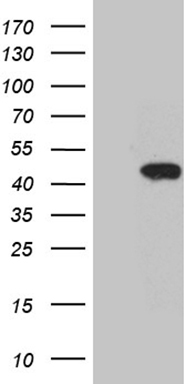G protein alpha inhibitor 1 (GNAI1) Mouse Monoclonal Antibody [Clone ID: OTI2D1]
CAT#: CF811907
Carrier-free (BSA/glycerol-free) GNAI1 mouse monoclonal antibody,clone OTI2D1
Other products for "GNAI1"
Specifications
| Product Data | |
| Clone Name | OTI2D1 |
| Applications | WB |
| Recommended Dilution | WB 1:500 |
| Reactivities | Human, Mouse, Rat |
| Host | Mouse |
| Isotype | IgG2a |
| Clonality | Monoclonal |
| Immunogen | Human recombinant protein fragment corresponding to amino acids 1-354 of human GNAI1 (NP_002060) produced in E.coli. |
| Formulation | Lyophilized powder (original buffer 1X PBS, pH 7.3, 8% trehalose) |
| Reconstitution Method | For reconstitution, we recommend adding 100uL distilled water to a final antibody concentration of about 1 mg/mL. To use this carrier-free antibody for conjugation experiment, we strongly recommend performing another round of desalting process. (OriGene recommends Zeba Spin Desalting Columns, 7KMWCO from Thermo Scientific) |
| Purification | Purified from mouse ascites fluids or tissue culture supernatant by affinity chromatography (protein A/G) |
| Conjugation | Unconjugated |
| Storage | Store at -20°C as received. |
| Stability | Stable for 12 months from date of receipt. |
| Predicted Protein Size | 40.2 kDa |
| Gene Name | Homo sapiens G protein subunit alpha i1 (GNAI1), transcript variant 1, mRNA. |
| Database Link | |
| Background | Guanine nucleotide binding proteins are heterotrimeric signal-transducing molecules consisting of alpha, beta, and gamma subunits. The alpha subunit binds guanine nucleotide, can hydrolyze GTP, and can interact with other proteins. The protein encoded by this gene represents the alpha subunit of an inhibitory complex. The encoded protein is part of a complex that responds to beta-adrenergic signals by inhibiting adenylate cyclase. Two transcript variants encoding different isoforms have been found for this gene. [provided by RefSeq, Jan 2012] |
| Synonyms | Gi |
| Reference Data | |
| Protein Families | Druggable Genome |
| Protein Pathways | Axon guidance, Chemokine signaling pathway, Gap junction, Leukocyte transendothelial migration, Long-term depression, Melanogenesis, Progesterone-mediated oocyte maturation, Tight junction |
Documents
| Product Manuals |
| FAQs |
| SDS |
{0} Product Review(s)
0 Product Review(s)
Submit review
Be the first one to submit a review
Product Citations
*Delivery time may vary from web posted schedule. Occasional delays may occur due to unforeseen
complexities in the preparation of your product. International customers may expect an additional 1-2 weeks
in shipping.






























































































































































































































































 Germany
Germany
 Japan
Japan
 United Kingdom
United Kingdom
 China
China




